Physical Address
304 North Cardinal St.
Dorchester Center, MA 02124
Tibial plateau fractures, inclusive of articular fractures of the proximal tibia and adjacent metaphysis, accounted for 1.2% of the fractures treated in Edinburgh's population of more than 500,000 during the year 2000, ranking 16th of the 27 reported anatomic fracture locations. This rank is approximately in line with fractures of the calcaneus and humeral shaft.
The age distribution of tibial plateau fractures follows a bimodal distribution in both males and females, with peaks occurring in young adults often from high-energy mechanisms, and again in the elderly with osteoporosis in whom lower energy mechanisms are common. An increasing frequency is noted in survivors of high-speed motor vehicle accidents (MVAs) due to improved standards and compliance with restraints and airbags; however, with the increasing age of the population, the number of fragility fractures of the proximal tibia is growing as well.
As is apparent from the demographics of the injury, the tibial plateau is vulnerable to high-energy and low-energy injury mechanisms because of its exposed and unprotected position in the lower extremity. Additionally, it is in line with the weight-bearing axis and has little protection from overlying musculature and integument. Furthermore, the tibial plateau has relatively forgiving ligamentous attachments that must allow for a large range of motion in a single plane.
Significant advances have been made in the diagnosis and treatment of these injuries. Over the past decade, greater knowledge and appreciation have been gained for the extent of associated soft tissue lesions in and around the knee, with resultant increased use of computed tomography (CT) scans and magnetic resonance imaging (MRI). Furthermore, indications and outcomes for various treatment strategies continue to be refined, as well as the most appropriate surgical approaches to treat various fracture patterns. The advent of staged protocols with delayed surgery and an emphasis on minimally invasive surgical strategies with gentle handling of soft tissues have contributed to decreased complication rates historically seen with these injuries. Optimal management of tibial plateau fractures demands an appreciation of the history of the treatment of these fractures to avoid repeating errors of the past.
The most interesting new territory since the previous edition includes increased appreciation for posterior plateau fractures that represent a shearing of the posterior coronal plane, which has manifested in the acceptance of a new classification as well as surgical approaches for this injury.
The knee in actuality is not a monoplanar joint as it exhibits complex motion, including flexion-extension of 0 to 140 degrees in the sagittal plane and 10 degrees of axial rotation, as well as posterior “rollback” of the femur on the tibia. The terminal rotatory component is often referred to as the “terminal screw home” effect, because as the knee approaches terminal extension, the tibia externally rotates until it locks with maximal constraint in full extension. Some patients, most commonly females, have physiologic recurvatum of 5 to 10 degrees, indicating hyperextension from ligamentous laxity.
The concept of femoral “rollback” is important in the understanding of knee kinematics, because its axis is not a point but a path of “centers” located in the femoral epicondylar region. As the knee flexes, the femur translates posterior or rolls back on the tibia, while the tibia internally rotates on the femur during screw-home motion.
Injuries to the tibial plateau occur most commonly as a result of one of the following mechanisms:
Force directed medially from the lateral side—valgus deformity
Force directed lateral from the medial side—varus deformity
Axial compressive force
Combination of axial and medial (valgus) or lateral (varus) forces
The respective femoral condyle in these mechanisms of injury exerts both shearing and compressive forces on the underlying plateau, which threaten the soft tissues inclusive of menisci, collateral, and cruciate ligaments.
Pure “split” fractures are more common in younger patients, in whom the strong subchondral bone of the tibial condyle is able to withstand the compressive force of the overlying femoral condyle, but the shear component of the load produces a split in the condyle. With age, however, diminished physical properties resulting from thinning of cortical and trabecular bone, make the “split-depression” fracture variants more common. Split-depression fractures become common in patients after the fourth decade of life and can result from low-energy injuries, even fragility fractures from simple falls.
A less common but increasingly recognized mechanism of injury involves a combined hyperflexion and valgus injury. This mechanism results in an isolated posterolateral tibial plateau split-depression fracture. Approximately 7% of fractures occur in this region of the plateau, and alternative surgical approaches are required to address them adequately.
Kennedy and Bailey were able to produce many of the commonly observed plateau fracture patterns by subjecting cadaver knees to valgus or varus forces combined with axial loads in the range of 1600 to 8000 pounds. Valgus loads in the range of 2250 to 3750 pounds produced mixed fractures with large variations in the amount and degree of joint impaction and condylar separation. These forces were thought to be comparable to those seen in the classic “bumper injury” when the patient's knee is struck by a car resulting in a valgus deforming force that loads the lateral plateau by the overlying femoral condyle. When axial loading exceeded 8000 pounds, severely comminuted fractures were produced in such studies and mimic what is seen typically after a fall from a height or motor vehicle collision in which an axial load through the floorboard drives through an extended knee. The magnitude of the force is proportional to the degree of fragmentation and degree of displacement.
In addition to the fracture, there may be associated soft tissue lesions of the ligaments or menisci. The lateral collateral ligament (LCL) acts during a varus force to cause medial plateau fractures with an associated tear of the LCL complex. Sometimes the posterior cruciate and even the peroneal nerve and popliteal vessel can be involved because of their fixed points at soft tissue tethers. With increased use of MRI for evaluating these fractures, recognition of associated ligamentous injuries has increased. The surgeon must also differentiate split fractures that are the result of a shearing force from rim avulsion fractures that are associated with knee dislocations and may indicate an unstable injury. These “rim avulsions” are known as a Segond fragment.
The articular surface is exposed to acute and sustained concentrations of multiple inflammatory cytokines after intraarticular fracture. These inflammatory cytokines have been associated with the development of primary and inflammatory arthritis, and research suggests that these factors could also play a role in the development of posttraumatic arthritis.
Haller et al. evaluated human synovial fluid for inflammatory cytokine concentrations after acute tibial plateau fractures with aspirations performed on the injured and uninjured knees. Patients who required an external fixator followed by delayed fixation underwent aspiration at both surgical procedures, showing a significant local inflammatory response after the tibial plateau fracture. Interestingly, there was not a detectable difference in inflammatory cytokine concentration between high- and low-energy injuries. Synovial fluid concentrations of IL-10, IL-8, IL-6, IL-1RA, and MCP-1 remained elevated at the second aspiration in patients undergoing staged fixation. The effect of the elevation of these markers on the articular cartilage has not yet been fully elucidated.
Tibial plateau fractures pose major threats to the structure and function of the knee joint. Immobilization alone in a plaster cast, if prolonged for more than 2 to 3 weeks, may result in an unacceptable degree of stiffness that does not respond well to physiotherapy. Traction with early motion preserves movement but does not ensure reduction because impacted articular fragments that are driven into the underlying cancellous bone of the metaphysis do not have any soft tissue attachment and are not reduced. The joint depression together with metaphyseal fragmentation may also result in angular deformity leading to a major degree of joint overload. In other words, ligamentotaxis alone cannot adequately restore articular reduction or alignment. Unless the joint is adequately reduced with alignment and stability of the limb allowing for early range of motion, major complications can be anticipated. Even with the most successful form of treatment, posttraumatic arthritis can develop, depending on the degree of initial joint loading and fragmentation.
Tibial plateau fractures are often associated with serious soft tissue damage. Tears of the menisci, particularly peripheral detachments, are common, as are collateral and cruciate ligament injuries.
Fractures of the lateral plateau are rarely associated with arterial or nerve lesions; however, fractures of the medial plateau, because they are associated with greater violence often representing a knee dislocation variant, are frequently associated with lesions of the peroneal nerve or popliteal vessel. The arterial lesions are most commonly seen either as an acute obstruction due to a complete tear or thrombosis, or as a delayed thrombosis due to propagation of an intimal tear.
Tibial plateau fractures, particularly if they extend into the diaphysis, may be associated with acute compartment syndromes because of hemorrhage and edema of the leg. Another important cause of compartment syndrome is reperfusion after successful treatment of an arterial occlusion, whether surgically or by relocation of a luxation.
The proximal tibia is subcutaneous except posteriorly. Anteriorly, it is covered only by the skin and subcutaneous tissues that overlie the tendons and ligaments that cross the joint. Severe contusions of this skin envelope occur particularly with high-energy injuries to the exremity, and most commonly if quick and adequate alignment and length to the limb are not restored. Therefore even in the absence of open fractures, the contused soft tissue envelope may be in jeopardy because of instability of the underlying fracture, severe swelling associated with the injury, or any injudicious or poorly timed surgical procedure. Fractures of the proximal tibia may become complicated by wound slough, infection, and osteomyelitis as has been demonstrated by the history of treatment for this condition.
The surgeon should try to understand the mechanism causing the fracture. This mechanism should suggest the likelihood of significant soft tissue injury. The history ideally indicates the direction and magnitude of the force causing the fracture, which is helpful in predicting soft tissue injury and guiding further evaluation. For example, whereas a valgus force to the lateral knee in a football player may suggest a medial collateral ligament (MCL) injury, a hyperextension deformity may indicate disruption of cruciate ligaments and vascular injury. An axial load sustained during an MVA with the knee in extension implies a crushing mechanism that may create more articular damage or soft tissue swelling.
Other patient-related considerations are important to determine during the history-taking process. Age and bone quality are generally related. A young adolescent may be skeletally immature and sustain a growth plate injury. A comminuted fracture in an elderly versus a young patient carries completely different implications. Knowing the age may tip the surgeon off to important comorbidities. It is important to ascertain comorbidities in these patients because soft tissue considerations must guide surgical choices. For example, smoking, diabetes, vascular disease, and congestive heart failure all negatively affect the healing capacity of surgical wounds.
Last, a patient's activity level, employment status, and recreational diversions say a lot about such issues as motivation, compliance, and physical demands after surgery. Higher educational background and socioeconomic status correlate strongly with improved functional outcomes.
The tibial plateau is vulnerable to high-energy and low-energy injury mechanisms.
Bimodal distribution of tibial plateau fractures:
Young adults—high-energy injuries
Elderly with osteoporosis—lower energy injuries
Split-depression fractures become common in patients after the fourth decade of life.
The magnitude of the force is proportional to the degree of fragmentation and degree of displacement.
Tibial plateau fractures need to be appreciated as soft tissue injuries with an associated fracture.
Surgical protocols must consider the following:
Staged protocols with delayed surgery
Minimally invasive surgical strategies
Gentle handling of soft tissues
The concept of femoral “rollback” is important in the understanding of knee kinematics.
Fractures of the lateral plateau are rarely associated with arterial or nerve lesions.
Fractures of the medial plateau are frequently associated with lesions of the peroneal nerve or popliteal vessel.
Significant local inflammatory response occurs after the tibial plateau fracture.
Ligamentotaxis alone cannot adequately restore articular reduction or alignment.
As the knee flexes, the femur translates posterior or rolls back on the tibia.
Approximately 7% of fractures occur in the region of the posterolateral tibial plateau.
Examination of a patient with a known or possible tibial plateau fracture begins, as it should for any injured patient, with the advanced trauma life support (ATLS) routines of primary and secondary survey. Immediate attention may need to be directed to resuscitation and treatment of injuries that threaten life or limb. The possibility of a popliteal arterial injury arises with any high-energy knee trauma. Rapid identification and surgical treatment are indeed limb saving and are discussed in some detail later in the chapter. Knee evaluation is part of the secondary survey unless exsanguinating local hemorrhage is present that demands immediate operative attention.
Frequently, the orthopaedic trauma surgeon is called to see an injured patient whose radiographs demonstrate a tibial plateau fracture. Attention must be paid to signs of open wounds, swelling, deformity, instability, or crepitus. Distal pulses must always be examined, as should compartmental soft tissue swelling and turgor.
For high-energy injuries, a thorough vascular assessment with documentation of an arterial pressure index (API) is mandatory. Even if the API is greater than 0.9, serial clinical examination, focused on swelling, motor function, sensation, and stretch pain, is advisable because patients with tibial plateau fractures and intact arteries may develop compartment syndrome during the first couple days after injury. If the API is less than 0.9, further vascular workup with an arteriogram is immediately necessary. We strongly recommend measurement of relative arterial pressure . Too often, physicians have focused on whether a pedal pulse is palpable or identifiable with a Doppler device. But this approach is not sensitive enough to exclude reliably a limb-threatening arterial injury.
Relative arterial pressure measurement compares the Doppler-aided systolic pressure of an injured lower extremity with that in an uninjured limb, which could be the opposite lower extremity, or perhaps more conveniently an uninjured upper extremity (also referred to as the ankle-brachial index [ABI]) ( Fig. 62.1 ). API measurement may be inaccurate in older patients with peripheral arterial disease, due to the lack of vessel compressibility with arterial calcification, which could yield a false-positive result. It has been shown that when the API falls within the normal range (excluding peripheral arterial disease), no further diagnostic screening is necessary.
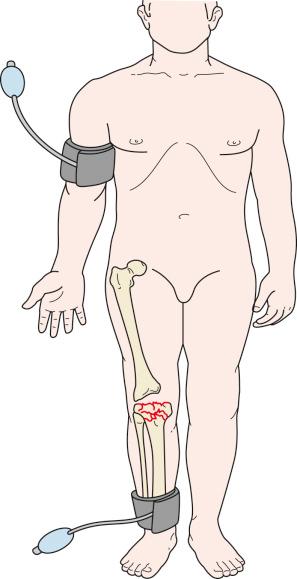
If possible, a neurologic examination to assess sensation and voluntary motor function is important and should be repeated periodically during the first day or two after injury. Both light touch and muscle strength of the tibial, superficial, and deep peroneal nerves should be assessed and documented. These signs may indicate peroneal nerve damage or signal a compartment syndrome. Firmness of the calf muscle compartments suggests this problem, as does pain with passive stretch of the foot and ankle flexors and extensors, which is a critical finding. Progressive pain out of proportion to the injury and deterioration of sensation or motor function are major warning signs of compartment syndrome.
When compartment syndrome develops, surgical release of the compartments should be performed along with application of external fixation to stabilize the fractures and allow for continued evaluation and treatment of the soft tissue envelope ( Fig. 62.2 ). Most often the noninjured knee and leg can be used as an internal control for examination comparison.
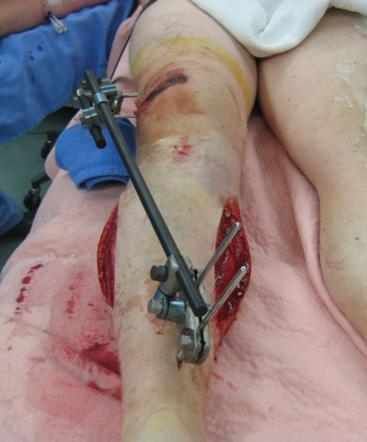
Particularly with severe injuries and in patients who arrive in shock, the initial appearance of the wound may not suggest damage that will become evident over the next 2 to 3 days. Excessive skin mobility or subcutaneous fluctuance may be the only tipoff to an internal degloving injury. Abrasions that appear superficial may progress to full-thickness eschars. Additional signs include ecchymosis, edema, and blistering, particularly if the fluid is bloody. Shiny skin that lacks normal wrinkles and is still swollen is at risk for wound slough if it is further injured by a surgical incision ( Fig. 62.3 ). Normal wrinkling is the best indication that swelling has resolved to the point that the surgeon can proceed with definitive care.
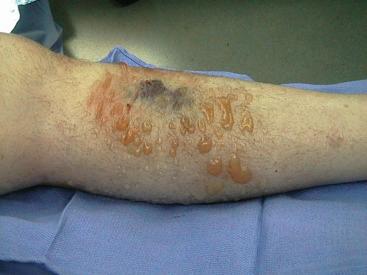
In low-energy injuries with minimally displaced fractures, an attempt at examining for stability with both gentle varus and valgus stress at 0 and 30 degrees is advisable. Any knee radiograph demonstrating displaced fractures should obviate such an examination. A patient with minimal displacement and a stable knee usually does not need surgical treatment. A Lachman examination for anterior cruciate ligament (ACL) deficiency may also be attempted. A straight leg raise assesses extensor mechanism integrity; however, these aspects of the examination are frequently limited by patient discomfort.
Tibial plateau fractures are frequently accompanied by proximal fibular fractures. Patients who sustain such associated fractures more frequently complain of lateral hamstring tightness and persistent lateral-sided knee pain. Treatment of proximal fibular fractures associated with tibial plateau fractures remains controversial. Options include open reduction and internal fixation (ORIF) with plates, screws, suture, or combinations thereof depending on the fracture configuration and associated injuries. A reasonable approach is to fix the tibia fracture and then examine the knee for instability. If the instability then includes a significant varus laxity in the setting of a fibular head fracture or if marked posterolateral rotatory instability is found, formal reconstruction should be considered. This is discussed later.
Tibial tubercle fracture, a type of avulsion of the patellar tendon, occurs commonly in association with high-energy fracture patterns, often associated with posterior cortex comminution, which would prevent typical lag screw fixation of this fragment. These occur in association with Schatzker type V and VI fractures in particular, with a reported incidence of 21.3%. This injury represents a disruption of the extensor mechanism and must be addressed at the time of definitive fixation. The significance of such a fracture, if missed and left unfixed, is that the patient will rehabilitate poorly because of pain and at times displace the fragment and develop an extension lag that is unrecoverable. Additionally, the presence of such a fragment may cause skin tenting and require that external fixation be applied with the knee in full extension to prevent pressure necrosis. Because it is an avulsion fracture in the saggital plane, a poorly performed knee lateral radiograph frequently can miss the fracture plane entirely. More commonly, however, the examiner is distracted by the more impressive displaced fragments of the medial and lateral plateaus, whose comminution blends in with a tubercle fragment. It is always wise to assess the level of the patella, as well as the integrity of the tibial tubercle, to reduce the risk of missing this component of a tibial plateau fracture. They may also be overlooked on CT when comminution may again be misleading. Sagittal plane two-dimensional (2-D) and three-dimensional (3-D) reconstruction images may best demonstrate tibial tubercle fractures, so they should be reviewed carefully with this possibility in mind ( Fig. 62.4 ).
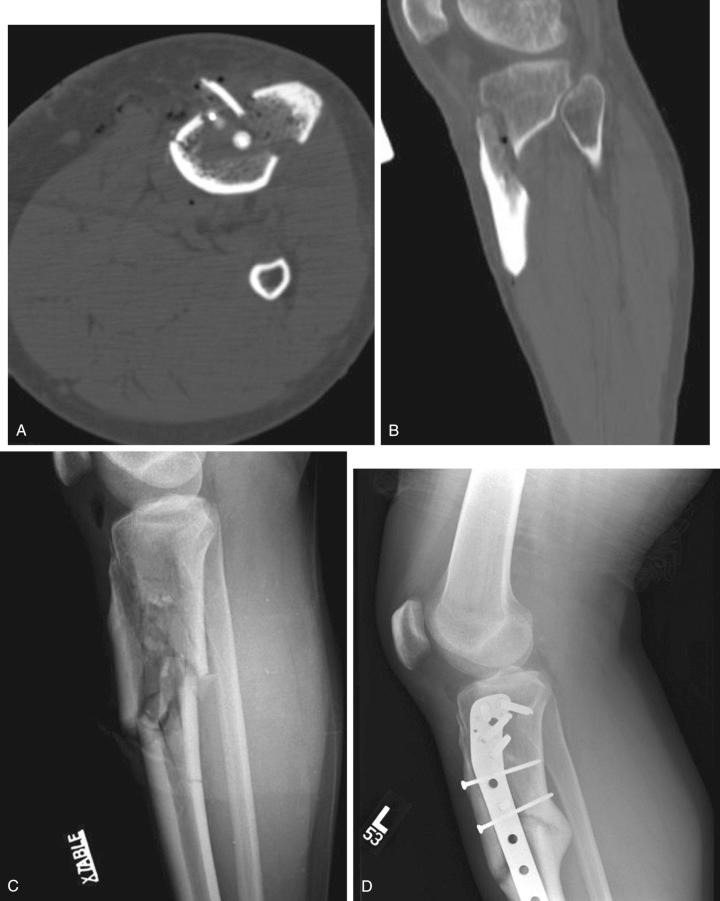
There are many intercondylar eminence fractures as a component of high-energy tibial plateau fractures, in particular Schatzker types IV, V, and VI ( Fig. 62.5 ). They are usually cruciate ligament avulsions. Thus their repair should help restore long-term knee stability ( Fig. 62.6 ). Isolated fractures of the intercondylar eminence also are seen. These typically represent pure cruciate ligament avulsions and may not involve the actual articular surfaces of the tibial plateau.

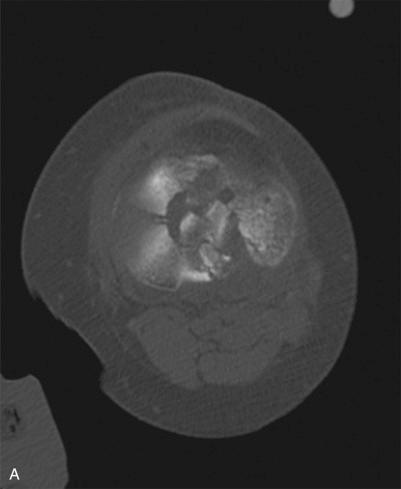
Many authors have now recognized the high association of meniscal, collateral, and cruciate ligament injuries. Stannard and colleagues performed MRI on 103 patients with high-energy mechanisms. They found 71% of patients tore at least one major ligament and 53% tore multiple ligaments. Additionally, the authors found that 49% sustained a meniscal tear. Gardner and colleagues used MRI to analyze 103 consecutive acute tibial plateau fractures. The authors found that only one patient in the entire series had no evidence of soft tissue injury. This incidence was significantly higher than previous reports in the literature, which range from 7% to 97%. Shepherd and colleagues reviewed MRI of 20 consecutive tibial plateau fractures that were deemed nonoperative based on the degree of displacement and found 90% of the patients had injuries to at least one ligament or meniscus based on MRI.
In the Stannard et al. MRI study of 103 patients there were 66 patients with Arbeitsgemeinschaft für Osteosynthesefragen/Orthopaedic Trauma Association (AO/OTA) type 41C fractures and 37 patients with AO/OTA type 41B fractures. Fifty patients (49%) sustained a total of 60 meniscal tears (25 medial, 35 lateral). Whereas medial meniscus tears were most commonly found in Schatzker type V fractures (38%), lateral meniscus tears were most commonly found in Schatzker type II fractures (55%).
In the report by Gardner and colleagues, 91% of the patients had evidence of a torn or peripherally separated meniscus. Medial meniscal tears were found in 44% of patients. It is important to recognize that 60% of the fractures in their series were Schatzker type II fractures, of which 73% had injuries to the lateral meniscus. Another important finding is that lateral capsular separation occurred in 100% of the Schatzker type I plateau fractures. Medial tibial plateau fractures were associated with a medial meniscal tear rate of 86%.
The incidence noted by Gardner and colleagues is higher than in previous or subsequent reports. In a study by Vangsness and associates of 36 consecutive patients with tibial plateau fractures, only 47% had associated meniscal pathology. In a study by Colletti and colleagues, lateral meniscal tears were noted in 45% and medial meniscal tears in 21% of patients in a series of 29 cases with tibial plateau fractures assessed by MRI. In another study by Bennett and Browner, 30 tibial plateau fractures were evaluated with diagnostic arthroscopy, revealing an overall meniscal pathology rate of only 20%. In another Gardner et al. study the authors found that depression greater than 6 mm and widening greater than 5 mm on a standard radiograph was associated with a lateral meniscal injury rate of 83% compared with 50% among fractures with less displacement. The authors suggested that in Schatzker type II tibial plateau fractures with depression or widening of at least 5 mm, surgeons should expect concomitant soft tissue injuries. A later study of 602 fractures by Stahl et al. demonstrated similar findings with regard to split-depression fracture. They found lateral meniscal tears requiring repair in 30% of patients. This was broken down into 45% of split-depression fractures ( P <0.001), 12% of pure lateral split fractures, 18% of pure depression fractures, 22% of bicondylar fractures, and 26% of intraarticular plus shaft fractures. Lateral meniscal tears associated with a split-depression fracture pattern were most commonly peripheral rim tears (83%).
It is clear by the variation in incidence among these studies that either there are different interpretations for what represents a meniscus tear or the technique or quality of the MRI examinations is different. The arthroscopist may fail to detect certain very anterior lesions, where they are likely to occur in lateral plateau fractures. Treatment of meniscal pathology is controversial because the natural clinical history of all these variants is unknown. Regardless, the critical role of the menisci has been well established. In a classic article by Walker and Erkman, contact stress analysis was performed on both medial and lateral tibial plateaus under various loads. Under no load, contact between the femoral condyles and their respective medial and lateral articulations occurs primarily on the menisci. Under loads of up to 150 kg, the lateral meniscus carried most of the load, but on the medial side, the load was shared almost equally between the meniscus and the exposed cartilage of the medial tibial plateau. In this context it seems that the importance of the lateral meniscus, particularly its role in stabilizing the knee joint, cannot be overstated.
If one considers the results of total meniscectomy in the development of posttraumatic arthrosis as noted by Fairbank, it seems intuitive that preserving the lateral meniscus is of prime importance. Peripheral meniscal detachments constitute the majority of meniscal injuries. Although radial tears of the meniscus should usually be débrided, peripheral detachments, often involving the outermost portion of the meniscus or its anchorage to the joint capsule, should be repaired to the coronary ligaments or even to a plate or screws as the implants and injury may dictate. A durable nonabsorbable suture is best used for this task. Suture anchors can be helpful in the cases in which reattachment is difficult because of poor integrity of the coronary ligaments. A peripheral meniscal tear in association with a tibial plateau fracture should never be considered an indication for meniscectomy.
It is possible that simply reducing a displaced plateau fragment approximates the coronary ligaments to the peripheral meniscal detachment and allows for healing without formal repair. This could explain the disconnect between the low rate of reported late complications related to meniscal tears and the high frequency with which present-day MRI detects such injuries acutely. In any case, maintenance of the menisci is critical. One study found that removal of a meniscus during surgery resulted in secondary degeneration in 74% of the cases compared with 37% when the meniscus was intact or repaired.
Several other studies have been performed to determine the incidence of collateral ligament injury associated with tibial plateau fractures. Methods of diagnosis in these different investigations vary from physical examination to operative findings to arthroscopy and MRI. The overall incidence ranges between 8% and 45%. Delamarter and Hohl reviewed 39 tibial plateau fractures and noted that ligamentous injury occurred in all types of tibial plateau fractures but most commonly in split-depression and pure depression injuries.
In Schatzker type II tibial plateau fractures, Gardner and colleagues noted a fibular collateral ligament tear incidence of 18% and in 36% of the MCLs. In their report of 103 operatively treated tibial plateau fractures, 29% of patients had complete fibular collateral ligament tears, 47% had partial fibular collateral ligament tears, 33% had complete MCL tears, and 57% had partial MCL tears. In this series, 60% were Schatzker type II fractures. In the series by Colletti and colleagues, fibular collateral ligament injuries were discovered in 34% of patients and MCL injuries in 55%. Bennett and Browner, in their study of 30 tibial plateau fractures, found an MCL lesion in only 20% of the patients and fibular collateral ligament lesions in only 3% based on diagnostic arthroscopy, physical examination, and stress radiographs ( Fig. 62.7 ).
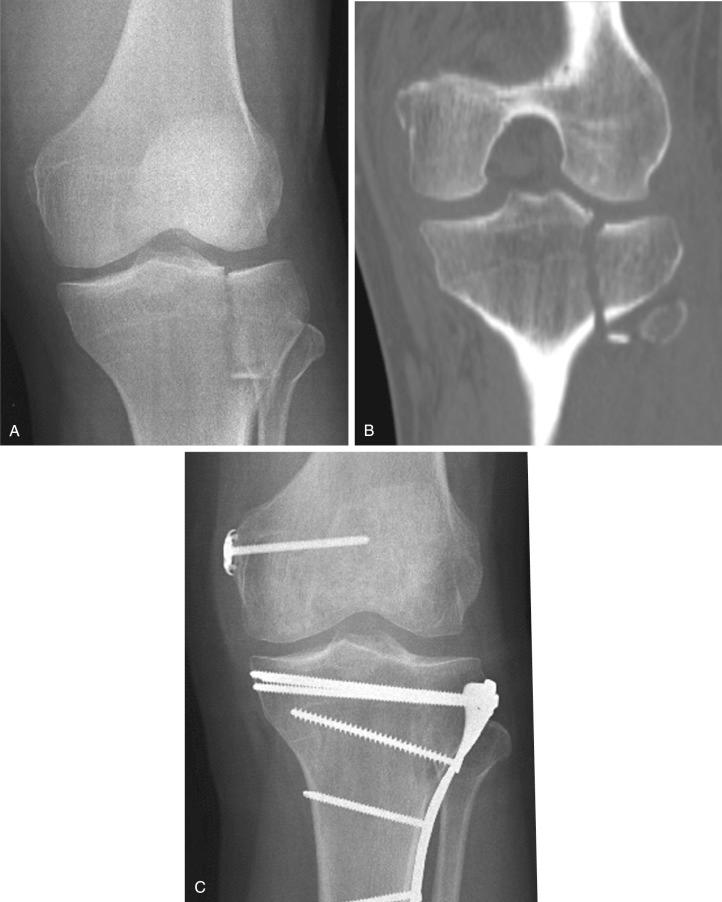
Injuries to the ACL and posterior cruciate ligament (PCL) in the setting of tibial plateau fractures have been described in numerous series. In Stannard and colleagues’ report on 103 tibial plateau fractures that underwent preoperative MRI, the authors found ACL injuries in 45 patients (44%), most commonly in Schatzker type V variants, occurring in 8 of 13 (62%). They were found in all variants, however, ranging from 15% to 62%.
In Gardner and colleagues’ previous preoperative MRI study of 103 patients with tibial plateau fractures, significant ACL injuries occurred in 57%. In contrast to the study by Stannard et al., Gardner et al. found Schatzker type II fractures rather than type V had the highest rates of complete ACL tears; however, footprint avulsions were noted in 71% of bicondylar Schatzker type V fractures but were common among all tibial plateau fracture types, ranging from 42% to 71%. In a more recent study by Gardner and colleagues, in Schatzker type II fracture patterns, the overall incidence of ACL injury was 47%, most of which were footprint avulsions. In Colletti and colleagues’ series of 29 patients, 41% were noted to have injuries to the ACL. In Bennett and Browner's series of 30 patients, injury to the ACL was noted in 10%.
The incidence of PCL injury is lower. Stannard and colleagues found PCL injuries in 41 patients (40%), most commonly in Schatzker type IV variants, occurring in 7 of 13 (54%). Gardner and colleagues previously reported a rate of 28%. Most of these were avulsions of the PCL. Footprint avulsions of the PCL were highest in Schatzker type I fracture patterns with an incidence of 67%. In a more recent study by Gardner and colleagues reviewing Schatzker type II fracture patterns, 25% were noted to have PCL lesions, of which most were PCL footprint avulsions. In Colletti and colleagues’ series of 29 patients, 28% were noted to have PCL injuries. Gardner and colleagues reviewed the literature of the reported incidence of associated soft tissue injuries in tibial plateau fractures and noted injury to the cruciate ligaments ranging from 8% to 69%. Bicruciate injuries were most common in Schatzker type IV variants in Stannard and colleagues’ series, seen in 6 of 13 (46%) ( Fig. 62.8 ).
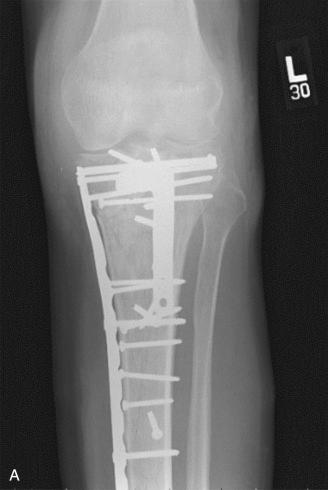
Damage to the posterolateral corner supporting structures of the knee has been increasingly defined and appreciated. In particular, popliteal fibular ligament (PFL) and popliteus tendon (PT) tears have been described in association with tibial plateau fractures ( Fig. 62.9 ). Stannard and colleagues demonstrated injury to the posterolateral corner structures in 46 of 103 (45%) patients in their series. This injury was seen most commonly in Schatzker type IV and V variants, both occurring in 62% of patients. In their previous study series of 103 patients, Gardner and colleagues reported that 68% of patients had tears of the PFL, the PT, or both.
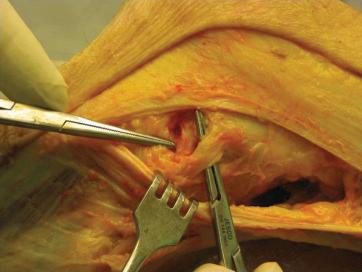
In 2003 Bennett and colleagues described anterior rim tibial plateau fractures with posterolateral corner injuries of the knee in 16 knees of 15 patients who had evidence of posterolateral corner injury on physical examination and MRI. Six knees showed evidence of tibial plateau fracture on MRI. Five of those six were anteromedial rim fractures. The authors concluded that anteromedial rim fractures of the tibial plateau occur rarely but are seen in the setting of a posterolateral corner knee injury ( Fig. 62.10 ).
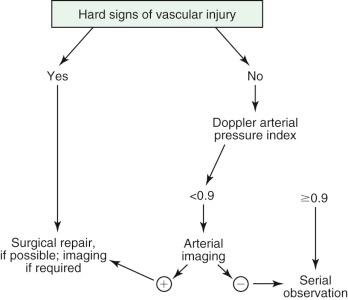
Neurovascular injury is rarely seen in most tibial plateau fractures. However, fracture-dislocations and high-energy medial condyle (Schatzker type IV) and bicondylar (Schatzker types V and VI) patterns do present an increased risk to neurovascular structures, in particular the popliteal artery and common peroneal nerve (CPN). Our current approach to vascular assessment is outlined in Fig. 62.11 .
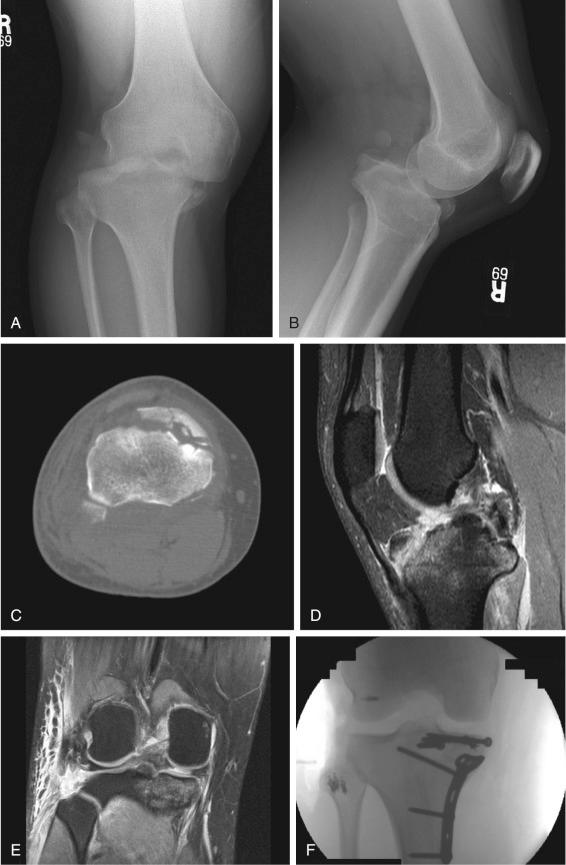
Although arteriography is rarely necessary if a patient has limb-threatening ischemia associated with a single fracture or dislocation, when more than one level of injury is present, it may be necessary for the vascular surgeon to localize the arterial obstruction. In such cases, imaging should be done rapidly with whatever technique is best suited to the needs of the patient and vascular surgeon and is within the institutional capabilities:
Angiography in the operating room (OR)
Rapid arteriography by a radiologist
CT arteriography
Duplex ultrasonography
Harrell and associates, in a retrospective review, noted that the incidence of popliteal artery injury with fractures about the knee was 3%, but clearly this rate is fracture specific and therefore institution specific, depending on the injury profile that presents to a given emergency department.
In a study by Bennett and Browner, only 1 patient in 30 had injury to the peroneal nerve, for an incidence of 3%. Myint and colleagues reported on a patient who sustained a CPN palsy caused by posterolateral displacement of a fractured lateral plateau.
Tibial plateau fractures represent a spectrum of bony and soft tissue injury. Because of the high rate of associated ligamentous injuries, most high-energy tibial plateau fractures should be considered fracture-dislocations. In other words, some tibial plateau fractures have associated significant ligamentous injuries that require reconstruction, and some knee dislocations have associated rim fractures of the tibial plateau that require fixation. The Hohl-Moore classification is often more helpful than that of Schatzker in classifying these fractures and predicting concomitant injuries and guiding treatment.
This classification may correlate better with prognosis particularly as it relates to injuries to the soft tissues. Perhaps the one to raise the highest concern is compartment syndrome due to the clinician's ability to intervene and thwart bad outcomes.
Compartment syndrome can be a devastating complication of tibia fractures, including the plateau. Schatzker type VI fractures and medial plateau fracture-dislocations appear to be particularly at risk. Park and colleagues retrospectively reviewed 414 patients and classified them into three groups (proximal, diaphyseal, and distal) based on the anatomic location of the fractures (AO/OTA fractures 41, 42, and 43, respectively). The authors found the rate of compartment syndrome for 186 proximal tibia fractures was only 1.6%.
However, Stark and colleagues retrospectively reviewed 67 patients with tibial plateau fractures and fracture-dislocations who were treated with provisional external fixation within 48 hours of injury. There were 50 Schatzker type VI fractures and 17 fracture-dislocation variants. The authors found 18 compartment syndromes (27%) in 67 extremities. Compartment syndrome developed after Schatzker type VI fractures in 9 of 50 (18%) and medial plateau fracture-dislocations in 9 of 17 (53%), mandating close observation of these variants.
Most authors, however, have found no relationship between application of knee-spanning external fixation and compartment syndrome. Egol and colleagues prospectively evaluated intracompartmental pressures in all four compartments at four time points during the external fixator application. The authors found that application of knee-spanning external fixation for stabilization of high-energy proximal tibial fractures and dislocations in 25 patients resulted in only transient elevations of intracompartmental pressures.
Compartment syndrome in the setting of tibial plateau fracture can be managed effectively with both one- and two-incision fasciotomy surgical techniques. Placement of fasciotomy incisions should take into account plans for future incision placement during definitive fixation whenever possible.
Progressive pain out of proportion to the injury and deterioration of sensation or motor function are major warning signs of compartment syndrome.
Normal wrinkling is the best indication that swelling has resolved to the point that the surgeon can proceed with definitive care.
In Schatzker type II tibial plateau fractures with depression or widening of at least 5 mm, surgeons should expect concomitant soft tissue injuries.
The importance of the lateral meniscus in particular and its role in stabilizing the knee joint cannot be overstated.
Peripheral detachments often involve the outermost portion of the meniscus or its anchorage to the joint capsule.
ACL injuries are related most commonly in Schatzker type V variants.
PCL injuries are related most commonly in Schatzker type IV variants.
Injury to the posterolateral corner structures was seen most commonly in Schatzker type IV and V variants.
High-energy medial condyle (Schatzker type IV) and bicondylar (Schatzker types V and VI) patterns present an increased risk to neurovascular structures.
Because of the high rate of associated ligamentous injuries, most high-energy tibial plateau fractures should be considered fracture-dislocations.
The Hohl-Moore classification is often more helpful than that of Schatzker in classifying these fractures and predicting concomitant injuries and guiding treatment.
Supine anterior-posterior (AP) and lateral radiographs are required for all patients with suspected or known fractures of the tibial plateau. Internal and external rotation oblique views of the knee are helpful in identifying and defining articular injuries. The internal rotation oblique displays the fibula in profile, eliminating tibiofibular overlap, because the fibula resides posterolateral to the tibia. This view demonstrates the posterolateral and anteromedial plateaus. The external rotation oblique projects the fibula more posteriorly, increasing tibiofibular overlap. This view provides better detail of the anterolateral and the posteromedial plateau surfaces ( Fig. 62.12 ).
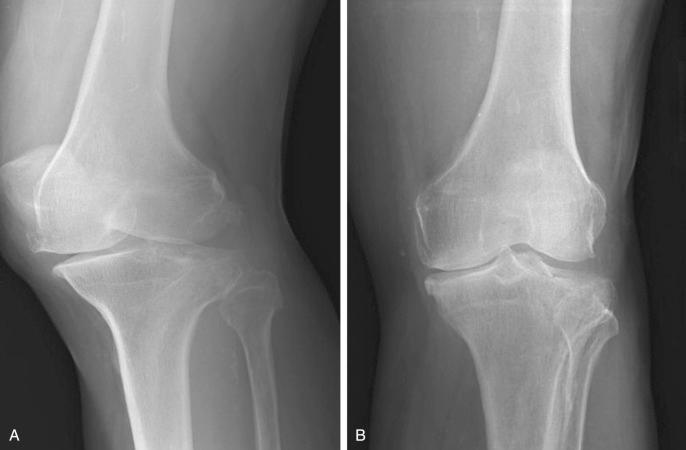
Well-performed AP, lateral, and oblique radiographs of the knee typically provide the necessary information when assessed by experienced orthopaedic surgeons. As with many articular fractures, one should obtain contralateral AP and lateral radiographs so that normal anatomy, which varies, can be used for preoperative planning and intraoperative comparison. To restore the bony architecture to a preinjury state, the surgeon must have knowledge of the patient's normal anatomy. Contralateral radiographs thus act as a template for fracture reduction, indicating tibial plateau height, condylar width and alignment in the coronal plane ( Fig. 62.13 ), and posterior slope of the plateau in the sagittal plane.
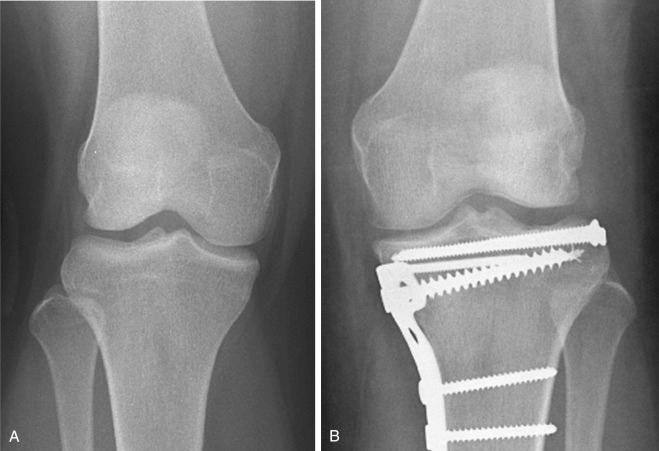
In addition to the previously mentioned views, the “tibial plateau view” as described by Moore and Harvey can be used. An AP radiograph is obtained with the knee in full extension and the radiograph beam directed approximately 10 to 15 degrees caudally ( Fig. 62.14 ) depending on the patient. This view parallels the posterior slope of the tibial plateau and yields a better view of the joint.
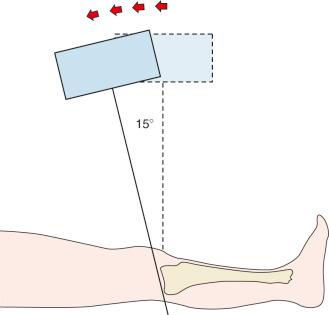
With appropriate interpretation of plain radiographs, many CT scans could be obviated. In many instances, well-done AP, lateral, and oblique views demonstrate perfectly well that there is minimal displacement of a fracture. If it is then clear that surgical indications are not met and that a patient is not an appropriate candidate given the displacement seen, no CT scan is necessary.
With the advent of staged protocols using initial spanning external fixation, repeating the lateral and AP radiographs of the knee after application of the spanning external fixator is important to ensure that appropriate provisional length and alignment have been restored. It is helpful not to place the radio opaque joints of the external fixator directly over the joint line for proper assessment to take place ( Fig. 62.15 ). Fracture fragment alignment is usually improved by ligamentotaxis during application of spanning external fixation; thus if a CT scan is anticipated, it should be done after application of the external fixator because the results are easier to interpret in this setting.
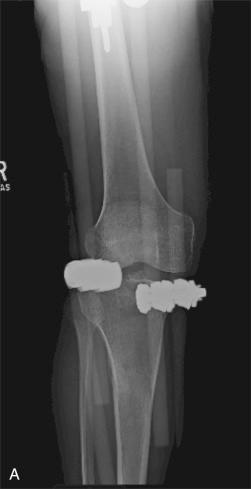
Several studies have demonstrated the utility of CT scans for assessing the degree of comminution and depression that is often underestimated with routine radiographs.
Standard 2-D CT scans with standard coronal and sagittal reconstructions help to assess the degree of comminution, trajectory of fracture lines, and injury nuances, which can enhance the surgeon's surgical tactic. Routine 2-D axial views are now commonly supplemented by 3-D reconstructions, providing even the novice an excellent understanding of fracture morphology ( Fig. 62.16 ). However, it is unclear whether the addition of 3-D reconstructions to standard 2-D imaging improves reliability of classification of tibial plateau fractures. Hu and colleagues concluded that 3-D imaging was superior to 2-D imaging and significantly improved interobserver and intraobserver reliability, but Doornberg and colleagues found that the addition of 3-D did not significantly improve reliability .
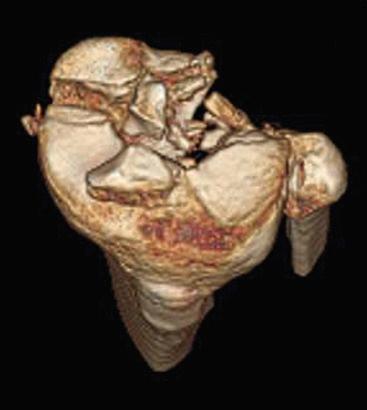
CT scans have led surgeons to reclassify fracture patterns and change the plan of treatment for tibial plateau fractures as shown in one study by Chan and associates. Macarini and colleagues reviewed 25 patients with a tibial plateau fracture and compared standard radiography with multiplanar and 3-D CT reconstruction. In 60% of patients, CT features led the orthopaedist to modify the treatment. The authors also noted that compared with axial CT, the 3-D reconstructions enabled a more accurate assessment of plateau depression and overall view of the fracture fragments. Although 3-D imaging may aid in determining fracture location, articular detail is lost because of volume averaging, so critical assessment of 2-D images is important for evaluation of the joint surface. Chan and colleagues reviewed 21 cases of tibial plateau fractures imaged with plain radiography and CT scans. Classification was changed in 12% of the cases with the addition of CT, and the treatment plan was changed an average of 26% of the time. The number of image slices may also be an important consideration. McEnery and colleagues performed an in vitro analysis of sensitivity and specificity of spiral CT and recommended 2-mm sections for optimal sensitivity and specificity.
Special attention must be given to the posteromedial plateau when evaluating CT. Barei and colleagues described the frequency and morphology of the posteromedial fragment on CT in 57 patients with bicondylar tibial plateau fractures. The authors found that the posteromedial fragment was present in 74% of patients and comprised a mean of 58% of the articular surface of the medial tibial plateau and 23% of the entire tibial plateau articular surface. Most important, perhaps, the mean sagittal fracture angle of the medial plateau was 81 degrees.
Higgins and colleagues subsequently described the morphology of the posteromedial fragment present on CT scan in 111 bicondylar fractures. They found that the fragment occurred in 59% of cases and on average accounted for 25% of the total joint surface. They found greater than 5 mm of articular displacement in 55% of cases. The posteromedial fragments exhibited vertical fracture patterns, with average sagittal angle of 73 degrees, suggestive of shear instability and vertical displacement. The presence of this fragment has significant clinical implications when deciding on reduction techniques and fixation constructs. Laterally based fixation may fail to adequately stabilize this fragment. Consideration should be given to direct reduction and fixation of this fragment through a posteromedial approach to ensure adequate fixation.
A well-designed cadaveric study evaluated the effects of progressive knee flexion on 10- and 20-mm osteotomies created at angles of 30 degrees in the axial plane with respect to the tangent of the posterior tibial plateau, and with 75 degrees in the sagittal plane representing a typical posteromedial fracture fragment. Axial compression only, compression with shear force, torque, and varus moments were then applied. The authors found that both fracture fragments displaced with knee flexion, even at low flexion angles. Although such fragments may initially seem nondisplaced after injury, posteromedial fragments similar to these tested are likely to displace during knee range-of-motion exercises in non–weight-bearing conditions. It is therefore imperative to obtain stable fixation of these fragments.
The role of preoperative MRI in tibial plateau fracture management is controversial and evolving. Some studies suggest the possible importance of MRI in assessing osseous and associated soft tissue lesions. However, neither the natural history of MRI-discovered soft tissue injuries nor the indications for surgical treatment of these injuries in the setting of a tibial plateau fracture have been established. It is possible, with further advances in quality and technique, that MRI could supplant CT as the imaging modality of choice if it can be found to consistently provide equivalent detail of osseous injuries.
Limitations of MRI include the difficulty of positioning claustrophobic and obese patients in a scanner. Patients with certain implanted metal objects, such as stents or pacemakers, cannot undergo MRI. Additionally, not all spanning external fixators are suitable for MRI scanners according to one study by Kumar and associates. The degree of ferromagnetism was studied in a number of orthopaedic implants including external fixator clamps by measuring the deflection at the portals of a 0.25- and 1.0-T (magnet) scanner. Although deflection was found to be significant with some ferromagnetic external fixator clamps, neither heating nor ferromagnetic force was a factor in multiple studied implants. The authors concluded that external fixator clamps exhibiting strong ferromagnetism should be avoided. Consideration should be given to applying titanium external fixator clamps for all spanning fixators to accommodate potential additional patient studies needed by neurosurgeons, spine surgeons, or knee surgeons. The stainless steel Schantz pins used for application of external fixators do not cause thermal problems nor do they displace. In fact, according to Kumar and associates, they are nonmagnetic. Both the orthopaedic and radiology departments must be sufficiently educated about these factors for MRI protocols to be executed without reluctance on the part of the radiology team.
As mentioned earlier, displaced bicondylar and medial condyle plateau fractures carry a significant risk of associated arterial injury. The same is true for any fracture-dislocation variant. Because arterial occlusion at the knee level often results in amputation unless perfusion is restored promptly, a high level of suspicion with rapid definitive assessment is required if limb loss is to be prevented.
It was previously thought that physical examination alone does not reliably identify the presence or absence of arterial injury. Numerous studies have been published supporting selective arteriography performed only in patients who have abnormal physical examination findings. Ten studies, including two prospective studies, have evaluated the use of selective arteriography in a total of 543 patients with knee dislocation. In each of these studies, physical examination alone was sufficient to detect all clinically significant vascular injuries . If the ABI is considered positive (<0.9), duplex ultrasonography or arteriography should be performed immediately.
However, the use of arteriography as a primary or routine screening tool for diagnosing arterial injury is cost-ineffective, has a poor risk-to-benefit profile, and is therefore unwarranted. In the case of an acutely ischemic leg, if the limb is considered salvageable and the ABI is less than 0.9, formal angiography may be required. Because of the few hours available before significant tissue necrosis, it is essential that a vascular surgeon be involved early in the care of these patients. Arteriography should never delay vascular consultation, arterial repair, and fracture stabilization. If additional information is required by the vascular surgeon to determine whether there is a need for formal vascular repair, evaluation with standard or CT angiography can be performed in the radiology suite. However, when the need for revascularization is clear, arteriography should be performed in the OR whenever possible to prevent unnecessary delays in revascularization.
Duplex ultrasonography is a fast and accurate examination. It carries no risks. Its effectiveness has been demonstrated in multiple studies ; however, the examination is operator and interpreter dependent and requires the ready availability of a skilled vascular ultrasonographer.
Contralateral radiographs act as a template for fracture reduction, indicating tibial plateau height, condylar width and alignment in the coronal plane, and posterior slope of the plateau in the sagittal plane.
Tibial plateau view (Moore view): AP radiograph with the knee in full extension and the radiograph beam directed approximately 10 to 15 degrees caudally.
Fracture fragment alignment is usually improved by ligamentotaxis during application of spanning external fixation; thus if a CT scan is anticipated, it should be done after application of the external fixator.
Although 3-D imaging may aid in determining fracture location, articular detail is lost because of volume averaging, so critical assessment of 2-D images is important for evaluation of the joint surface.
Arteriography should never delay vascular consultation, arterial repair, and fracture stabilization.
Currently, the most common systems for classifying tibial plateau fractures are the Schatzker classification and the AO/OTA classification systems. Schatzker's classification was based on fracture appearance on plain radiographs. CT (and MRI) has significantly improved fracture interpretation by clearly demonstrating the extent of joint surface depression, comminution, and bony displacement. Although the Schatzker system may be easier to remember, the AO/OTA comprehensive classification is now commonly used by scientific journals and therefore warrants understanding. The AO/OTA system has also been shown to have a higher interobserver agreement.
Additionally, the Hohl-Moore classification can be applied to fracture-dislocation variants that do not “fit” into the Schatzker classification. The Schatzker classification has been found to be superior to the AO/OTA system and the Hohl-Moore classification in terms of reliability measures, although none of these classification systems has been found to be ideal.
Although classification of the fracture pattern is emphasized in this chapter, soft tissue considerations are paramount. Soft tissue injury severity is suggested by the amount of comminution and displacement of bone fragments, which reflect the amount of transferred energy. This appreciation of soft tissue injury is of ultimate value in determining surgical approach and timing. The system of Oestern and Tscherne is helpful in classifying the severity of soft tissue injury.
The AO/OTA classification was published in 1996 and is used for evaluating all long bone fractures, in contradistinction to regionally based classification systems such as the Schatzker classification for tibial plateau fractures. In the AO/OTA classification, the proximal tibia is distinguished by the number 41 (the 4 refers to the tibia, and the 1 refers to the proximal segment, equal in length to the joint line width at the knee). Within each bone segment, the AO/OTA classification divides fractures into three types, denoted as A, B, and C:
A—extraarticular
B—partial articular
C—complete articular
Generally, these different types (A, B, and C) reflect ascending complexity in terms of injury nuances and treatment considerations, as well as ascending energy in their creation.
Type A fractures are extraarticular, which may occur in the metaphysis or epiphysis. Type B fractures involve only a portion of the articular surface. In these fracture patterns, part of the joint surface retains its continuity with the diaphysis. In addition to less severe injuries, they may represent high-energy injuries as well, such as the case of the Schatzker IV fracture, which represents a dislocation variant as discussed previously. Significant displacement or medial plateau involvement indicate these serious injuries.
Type C fractures are “complete articular” fractures in which the articular surface is dissociated completely from the diaphysis so that there is no continuity between any articular piece and the diaphysis.
Each of the three fracture types (A, B, and C) is divided into three groups, numbered 1, 2, and 3. Each of the groups is further divided into subgroups, indicated by the decimal notation 0.1, 0.2, and 0.3. The group and subgroup numbers were assigned in order of presumed severity, and they are specifically defined in the AO/OTA classification.
Type A fractures are extraarticular. Group A1 is a special category for avulsion fractures: A1.1 denotes avulsions of the proximal fibula, A1.2 of the tibial tubercle, and A1.3 of the intercondylar eminence and cruciate ligament attachments. Group A2 fractures are simple (two-part) metaphyseal fractures. The subgroups are 0.1—oblique in frontal plane, 0.2—oblique in sagittal plane, and 0.3—transverse fractures. Group A3 fractures are multifragmentary fractures that cross the metaphysis. The subgroups of A3 are 0.1—single wedge fragment, which involves only one side of the metaphysis; 0.2—comminuted wedge fragment; and 0.3—complex metaphyseal fracture with a comminuted zone extending all the way across the fractured metaphysis. The groups and subgroups of types B and C proximal tibia fractures are illustrated in Figs. 62.17 and 62.18 and described in their legends.
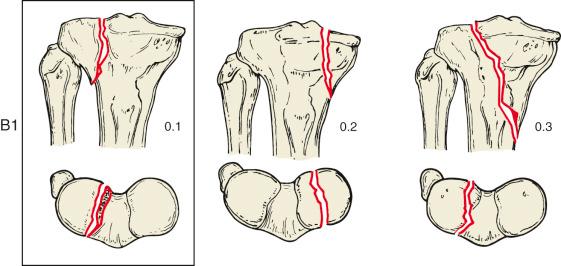
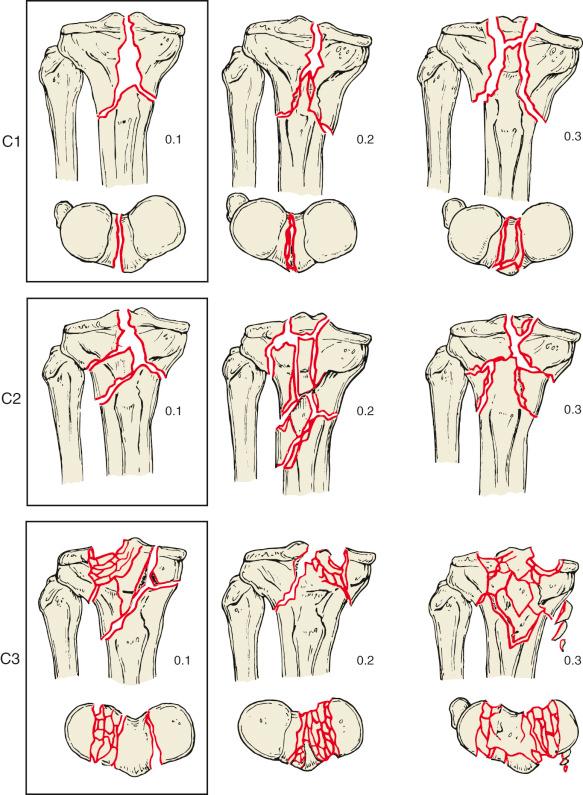
The Schatzker classification, first described in 1979, is popular in North America. It combines fracture location and pattern and separately recognizes medial plateau fractures. Schatzker's types are assigned in presumed increasing order of severity. The attractiveness of this classification system is related to its few types; that its verbal descriptions are familiar, simple, and easy to remember; and that it offers guidance for planning treatment. As a general rule, the Schatzker classification can be divided into low-energy variants (types I to III) and high-energy variants (types IV to VI). Alternatively, this classification can also be divided into unicondylar (types I to IV) and bicondylar (types V and VI). It is worthwhile discussing the characteristics of each of the Schatzker fracture patterns.
Schatzker type I is most common in young patients with hard cancellous trabeculae and good bone density, in which case the joint does not crush, but a pure split is created. The fracture line typically occurs in the sagittal plane ( Fig. 62.19 ). For reference purposes, this is a partial articular fracture and is therefore considered a type 41B1.1 fracture in the AO/OTA system.
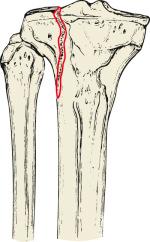
Schatzker type II is typically associated with either greater energy than a type I or with poor bone quality. This split-depression fracture of the lateral tibia condyle occurs most commonly in the fourth decade of life. In this fracture pattern, the cancellous bone underlying the articular surface cannot withstand the load from the axial force of the lateral femoral condyle and thus sustains a depressed articular region as well as the split component ( Fig. 62.20 ). For reference purposes, this correlates with the AO/OTA classification type 41B3.1.
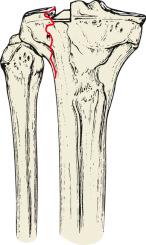
Schatzker type III fractures are associated with poor bone quality and can be caused by very low-energy mechanisms. This fracture pattern is amenable to the arthroscopically assisted fixation technique described later in this chapter. Type III is a pure depression fracture of the lateral plateau commonly diagnosed in elderly adults and can be considered a fragility fracture. In older patients with osteoporosis in whom the cancellous bone underlying the articular surface is more porous than normal, the bone crushes rather than splits ( Fig. 62.21 ).
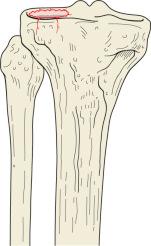
In a 2005 study by Gardner and colleagues, 103 MRIs on consecutive tibial plateau fractures were performed, and the authors found no true cases of pure depression type III fractures. In every case considered to be a type III fracture by plain radiographs, a peripheral split was noted on MRI. These findings suggest simply that occult fracture lines cannot always be detected on plain radiographs. The clinical significance may therefore be that one should not assume the lateral cortical envelope is stable and will not displace, and thus treatment may need to include lateral cortical support. Schatzker's classification, based on radiographs, does not seem to be upstaged by these MRI findings, which merely complement our understanding of the pattern. For reference purposes, this fracture correlates to the AO/OTA classification types 41B2.1 and 41B2.2.
Schatzker type IV fractures of the medial condyle may not violate the medial articular surface. They typically pass more laterally, through or lateral to the intercondylar eminence, and separate the medial plateau from the remainder of the tibia. Medial plateau fractures involve higher energy mechanisms and shearing forces. In fact, they represent a variant of knee dislocation because the MCL and cruciate ligaments stay attached to the medial condyle while the lateral plateau and shaft displace laterally away from the femur and medial plateau. The fracture may be a pure sagittal split but more commonly is oblique to the frontal plane, with the apex of the fracture occurring posteromedially ( Fig. 62.22 ). An important clinical implication of medial tibial plateau fractures is that associated arterial and peroneal nerve injuries are relatively frequent. They should be seen as quite different from partial articular (type B) fractures involving the lateral plateau, which are less unstable and result from lower energy injuries.
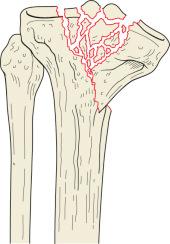
Although medial tibial plateau fractures account for approximately 10% of all tibial plateau fractures, this is the fracture pattern that has the highest association of injuries to the neurovascular structures and cruciate ligaments as well as with compartment syndrome. ACL and PCL injuries and bony avulsions are common in Schatzker type IV fractures.
Bear in mind that radiographs are static images, which do not reveal the maximal displacement that occurred at the time of injury. Thus even less displaced medial plateau fractures are at higher risk of neurovascular injury. Rarely, medial plateau fractures may be stable, but even these may surprise the surgeon with late displacement. For reference purposes, medial tibial plateau fractures correspond to the AO/OTA classification types 41B1.3, 41B2.3, 41B3.2, and 41B3.3.
Schatzker type V fractures are total articular injuries that involve wedge fractures of both medial and lateral plateaus. The intercondylar eminence remains more or less intact. Schatzker recognized a typical “inverted-Y” pattern and classified his type V plateau fractures as 41C1.1, 0.2, or 0.3—noncomminuted total articular fractures in which both the medial and lateral condyles are detached from each other and from the underlying metaphysis. Occasionally, the combination may include a split or split-depression fracture of the lateral plateau in addition to a separate medial plateau fracture. Because the cruciate ligaments typically remain attached to the intercondylar eminence and one plateau, there is usually less femorotibial instability and through ligamentotaxis traction often achieves a reasonably congruent reduction, but without surgical stabilization, loading results in distal displacement of the condyles and with widening of the intercondylar gap. This pattern is unlikely to be associated with a knee dislocation. CT or high-quality traction radiographs may be needed to demonstrate clearly their bicondylar, total articular pattern ( Fig. 62.23 ).
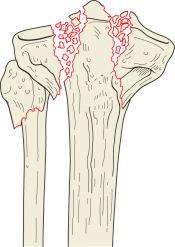
The Schatzker type VI tibial plateau fracture is a bicondylar fracture that involves both medial and lateral tibial plateaus but has more comminution and complete separation of the articular surface (including the eminence) from the diaphysis ( Fig. 62.24 ). These are typically high-energy injuries commonly associated with severe articular involvement and soft tissue injury. Multifragmentation of at least one plateau is common. Metaphyseal comminution may be extreme and extend into the diaphysis. These displaced, comminuted, bicondylar, proximal, tibia fractures typically have severe soft tissue injury whether they are closed or open. They carry a significant risk of wound slough if operated on early, particularly through extensile midline incisions. This pattern should serve as a warning for possible compartment syndrome and neurovascular injury; thus serial neurologic and vascular assessment should be performed. For reference purposes, these fractures correspond to the AO/OTA classification types 41C2 and 41C3.
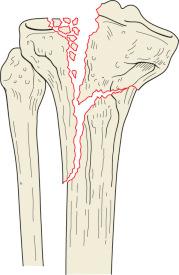
The Moore classification is applied to fracture-dislocation variants that do not “fit” in the Schatzker system ( Fig. 62.25 ). Moore type I accounts for 37% of tibial plateau fracture-dislocations and involves the medial side and is most apparent on the lateral view. The fracture line is typically in an oblique coronal-transverse plane at a 45-degree angle to the medial plateau and may extend to the lateral side. It is associated with avulsion fractures of the fibular styloid, insertion of the cruciates, and the tubercle of Gerdy. Capsular disruption and ligamentous injuries are common.
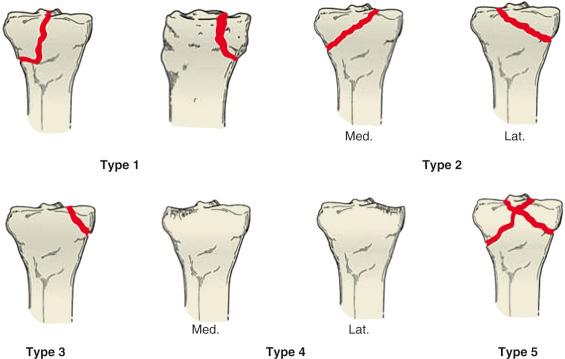
Moore type II fractures constituting 25% of all fracture-dislocations may involve the medial or lateral plateau and can be distinguished from the Schatzker type IV fracture by a fracture line extending into the opposite compartment beneath the intercondylar eminences. The opposite collateral ligament is involved in half of fractures, resulting in fracture or dislocation of the proximal fibula. It has been found that about 12% result in neurovascular injuries. Stress testing is necessary to determine occult ligament injury.
Type III rim avulsion fractures constituting about 16% of fracture-dislocations involve almost exclusively the lateral plateau, with avulsion fragments of the capsular attachment, the Gerdy tubercle, or plateau. In this type, disruption of the ACL or PCL is common but meniscal injury is thought to be rare. Neurovascular injuries occur in 30% of this variant because of their nature of dislocation.
Type IV rim compression fractures account for 12% of all fracture-dislocations and are most akin to Schatzker type III fractures; however, these are almost invariably unstable.
The opposite collateral ligament complex and usually (75% of patients) the cruciate ligaments are avulsed or torn, allowing the tibia to sublux to the extent that the femoral condyle compresses a portion of the anterior, posterior, or “middle” articular rim.
Type V four-part fractures constituting about 10% of all fracture-dislocations are also invariably unstable. Neurovascular injury occurs in 50% of fractures. The popliteal artery and the peroneal nerve are injured in more than one-third of cases. Both collateral ligaments are typically disrupted with the bicondylar fracture, and the stabilization provided by the cruciates is lost because the intercondylar eminences are separate fragments.
The Chertsey classification is the only mechanistic system currently in use. It is primarily used in Europe.
Chertsey 1: Valgus
Chertsey 2: Varus
Chertsey 3: Axial
Although one study found the Chertsey classification to be significantly more reliable than the Schatzker classification with regard to interobserver reliability and intraobserver reliability, the utility of this classification system with regard to predicting other injuries and assisting with preoperative planning has not been proven.
The three-column classification is primarily CT based and divides the tibial plateau into:
Medial column
Lateral column
Posterior column (subclassified as medial part or lateral part) ( Fig. 62.26 ).
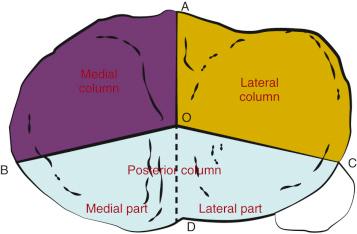
This classification can be used to systematically assess and classify fracture patterns in order to:
Identify column(s) injured and locate associated articular depression or comminution
Determine injury mechanism including varus/valgus and flexion/extension forces
Determine surgical approach as well as location and function of fixation.
Patange Subba Rao and colleagues evaluated interobserver reliability and intraobserver reproducibility between the three-column classification and Schatzker classification systems using 2-D and 3-D CT models. All patients were classified into Schatzker and three-column classification systems using radiographs and 2-D and 3-D CT images. The interobserver reliability was evaluated in the first round and the intraobserver reliability was determined during the second round 2 weeks later. They found statistically significant different interobserver values in both rounds, with the three-column classification having excellent statistical agreement. The intraobserver reproducibility for the three-column classification improved compared with the Schatzker classification as well. The three-column classification seems to be an effective way to characterize and classify fractures of the tibial plateau.
Multiple other studies have demonstrated the usefulness of this classification in assessing fracture morphology, particularly for posterior column involvement and injury mechanism, and it guides surgical treatment.
The posterior shear tibial plateau fracture described by Bhattacharyya and colleagues recognized a subset fracture pattern of the medial tibial plateau fracture that includes pure posterior fracture fragments. These posterior shear fractures, with a more or less coronal plane orientation, typically involve anterior subluxation of the anterior plateau and attached tibial shaft, but the posterior plateau fragments remain colocated with the femur posteriorly ( Fig. 62.27 ). This fracture does not fit into Schatzker's classification and may be regarded as a bicondylar variant and a type of knee dislocation. A posterior approach with fixation applied to the posterior surface of the proximal tibia is recommended for these injuries.
Schatzker's classification was based on fracture appearance on plain radiographs.
Schatzker's types (I to VI) are assigned in presumed increasing order of severity: low-energy variants (types I to III) and high-energy variants (types IV to VI).
ACL and PCL injuries and bony avulsions are common in Schatzker type IV fractures.
Hohl-Moore classification can be applied to fracture-dislocation variants.
The system of Oestern and Tscherne is helpful in classifying the severity of soft tissue injury.
The three-column classification (Luo classification) seems to be an effective way to characterize and classify fractures of the tibial plateau.
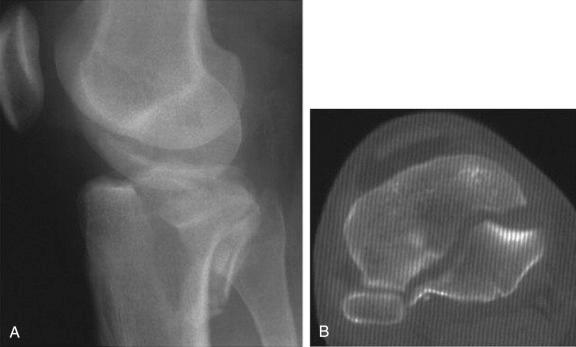
Charnley recognized in 1961 that anatomic reduction and early motion were desirable in the treatment of intraarticular injuries, but the techniques of surgery and internal fixation available at the time made these objectives of treatment unattainable. Attempts at early motion after internal fixation frequently resulted in pain because of instability, with resultant loss of fixation and varying degrees of malunion or nonunion. Surgery combined with plaster immobilization resulted in even greater stiffness than plaster immobilization alone. The pathophysiology of joint stiffness was poorly understood, and stiffness after surgery was blamed on the added trauma of surgery and the periarticular location of the fixation device. Therefore surgery became considered to be the last resort, and nonoperative techniques were generally favored. The phases of treatment were evaluation, reduction, immobilization, and rehabilitation. Rehabilitation followed fracture union, resulting invariably in joint stiffness.
Apley pioneered early joint rehabilitation and developed successful methods of traction that permitted early motion of joints while providing sufficient immobilization for the fracture to unite. He applied these techniques to the treatment of tibial plateau fractures and reported what he considered to be satisfactory results compared with the results of surgery.
The difficulty in evaluating the preceding studies is that the authors reported the results of treatment collectively without analyzing the types of tibial plateau fractures. Classification categories such as undisplaced, slightly displaced, and severely displaced, amplified by such terms as vertical or oblique fracture lines split or comminuted, were not helpful for separating fracture types with intrinsically different prognoses. Furthermore, these authors compared the results of the best nonoperative treatment with those of surgical treatment methods that would be considered unacceptable by current standards.
The development by the AO group of less traumatic techniques for open reduction and stable fixation, including new principles for internal fixation that advocated absolute stability and early motion, and of new implants and instruments that facilitated the attainment of the new goals of ORIF, brought about a revolution in fracture surgery. However, as surgical treatment became increasingly popular, high-energy fracture types (Schatzker types IV, V, and VI) were often managed with large extensile approaches. The usually lengthy operation and surgical approach through a tenuous soft tissue envelope, combined with the use of multiple implants, led to complication rates as high as 50% in some studies.
For these more complex injuries, contemporary surgical techniques have evolved to include concepts such as indirect reduction, antiglide fixation, and composite fixation, as advocated by Mast and colleagues. Newer devices such as cannulated screws, monolateral external fixators, anatomic periarticular plates, and external fixation techniques based on circular Ilizarov-type fixators with tensioned small wires have been used in concert with limited surgical approaches (guided by CT and careful preoperative planning) to achieve excellent results with fewer surgical complications.
Early attempts at internal fixation were fraught with complications in large part because of poorly timed surgical approaches that insulted the tenuous soft tissue envelope of the fractured knee. Extensile approaches were used too soon after injury. Temporary use of knee-spanning external fixators was unusual, and minimally invasive surgical strategies had not been developed. Wound dehiscence and infection too frequently developed, giving open reduction a bad name.
The concept of staged fixation has now gained favor. When the soft tissues are significantly compromised, immediate exposure for internal stable fixation is risky. Overall limb realignment and stabilization, important for soft tissue healing, can be achieved with an external fixator that initially spans the zone of injury. For tibial plateau fractures, these typically extend from the femoral shaft to the tibial shaft.
If the plateau fracture is open, the wound may provide adequate access for anatomic reduction and secure fixation of the articular surface. However, further exposure for internal fixation may increase the risk of wound slough unacceptably, especially if done during the first days after injury. If the initial fracture is not open, it is wise to delay the ORIF until the soft tissue envelope has recovered enough to tolerate exposure adequate for articular reduction. During this period of soft tissue recovery, external fixation splints the fracture and maintains general ligamentotaxis of the major metaphyseal and diaphyseal fracture fragments.
When the soft tissues have recovered sufficiently to allow a secondary procedure, delayed fixation can be accomplished through a safe operative corridor of healthy soft tissues.
Tibial plateau fractures are not emergencies unless they are open or associated with a knee dislocation, compartment syndrome, or vascular lesion. If the knee region is relatively stable, perhaps with hypermobility in a single plane, a splint may provide satisfactory temporary support.
An external fixator that spans the knee joint provides immediate temporary stability. Urgent external fixation should be considered for any patient with a grossly unstable proximal tibia fracture, vascular injury, open fracture, or a significant closed soft tissue injury, especially whenever definitive skeletal stabilization must be deferred. If properly applied, it stabilizes the injured area well, maintains traction, provides stability through soft tissue tension and ligamentotaxis, improves quality and usefulness of imaging studies, and avoids gross motion and redislocation (see Fig. 62.8 ). Compared with the alternatives, it provides a vastly better environment for soft tissue recovery and wound care. It facilitates patient care and patient transportation within and between institutions.
Most important, it has been found that a staged protocol involving temporary spanning external fixation before formal definitive fixation for high-energy tibial plateau fractures is associated with low rates of deep infection and wound complications after conversion to definitive fixation. For these reasons, we strongly advocate for the routine use of temporizing external fixation in high-energy, axially unstable variants, and those with significant soft tissue injuries.
Vascular injury is rarely seen in most tibial plateau fractures. However, fracture-dislocations, medial plateau fractures (Schatzker type IV), and high-energy bicondylar fractures (Schatzker types IV and VI) do present a risk to the vascular structures, specifically the popliteal artery and trifurcation. In these cases, application of a knee-spanning external fixator is indicated to provide stability and protect the vascular repair.
Debate centers on whether the fixator should be applied first, after temporary shunt placement, or after definitive vascular repair because anecdotal concern exists regarding the risk of disruption of the vascular repair during manipulation of the extremity after arterial repair.
If an arterial repair is required, a bridging external fixator should be applied rapidly first to restore length and stability, thereby aiding the vascular surgeon. One of the most common and preventable mistakes is to repair the vessel with the fracture in a displaced position before external fixation, leading to inadequate “slack” being left in the vascular repair to allow restoration of tibia length and alignment after repair.
Alternatively, a femoral distractor can be used to bring the fracture out to length and provide enough stability to facilitate temporary shunting or definitive arterial repair.
Because most vascular surgeons use a rather extensive posteromedial exposure, we do not recommend further metaphyseal reconstruction until the vascular access wound has healed. In most circumstances, lower leg fasciotomies should accompany the vascular repair, and certainly whenever the warm ischemia time exceeds 4 hours or other factors suggest risk of reperfusion-related compartment syndrome.
Patients who present with open injuries should be carefully evaluated for the location and severity of the open wound. An open fracture of the tibial plateau is surgically urgent. The fracture should be thoroughly débrided and stabilized to prevent infection. Adjunctive intravenous antibiotics and appropriate tetanus prophylaxis are required. The decision about how best to provide the desired stability usually presents the most difficult problem.
After initial irrigation and débridement and external fixation, the patient should be returned to surgery within 48 hours for a second assessment of the wound and débridement if needed. When a healthy wound has been established, delayed primary closure, or other procedures if required, should accomplish wound closure within 3 to 5 days.
If adequate débridement can be accomplished, the fracture pattern is amenable, and the open wound coincides with the planned location of fixation hardware, fixation of the articular portion of the fracture can be carried out at the time of presentation after thorough irrigation and débridement. However, this should be done with the least possible additional dissection and soft tissue trauma. The smallest amount of hardware consistent with stable fracture fixation should be chosen.
Immediate internal fixation for open fractures is not typically indicated in open tibial plateau fractures. The risk-to-benefit ratio must be carefully assessed when contemplating primary internal fixation. Internal fixation for open fractures has been shown to be beneficial in patients with multiple injuries, massive or mutilating limb injuries, open fractures with vascular injuries, and open intraarticular fractures. Rotational or free flap coverage of the joint and soft tissue defect should be undertaken as soon as a healthy wound tissue is achieved. An appropriate goal is to obtain soft tissue coverage within the first 3 to 5 days.
When faced with soft tissue defects (open Gustilo and Anderson type IIIB injuries), two approaches are generally accepted. Either a “fix and flap” can be arranged with plastic surgery, consisting of either definitive ORIF, or the wound can be covered and definitive fixation can be delayed until the soft tissue envelope has healed. For patients in whom definitive fixation is to be delayed and rotational or free vascularized flap procedures are fulfilled, reconstruction should typically be delayed at least 4 to 6 weeks after definitive wound coverage. At that time, the flap can usually be elevated safely in a manner that avoids or protects its vascular pedicle, and plate fixation can be applied as needed, with simultaneous bone grafting for bone defects in these selected fractures.
We recommend that metaphyseal or diametaphyseal bone grafting be performed on a delayed basis after complete wound healing has been achieved. Typically, a cement spacer with eluting antibiotics can be inserted into the defect and left until the soft tissue envelope is healed. Again, this is typically performed at 4 to 6 weeks to allow recovery of the soft tissue envelope. The spacer can then be removed and bone grafting performed via the Masquelet technique.
Become a Clinical Tree membership for Full access and enjoy Unlimited articles
If you are a member. Log in here